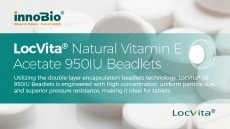Summary of vitamin, mineral responses presented at conference
vitamin and mineral levels was presented in Brussels last week,
said to have identified the principle problems ahead of the next
stage.
The discussion paper, published in June, invited responses from stakeholders on six questions on how the EC should go about setting maximum levels, which forms part of the 2002 Food Supplements Directive and the forthcoming regulation on fortified foods.
Presenting the summary Fabio d’Atri, administrator, food law, Nutrition and Labelling Unit, DG Sanco, European Commission, said that a total of 58 responses were received “from the whole range of stakeholders”.
He concluded that there was an overall agreement on the necessity of EU maximum amounts, and on the classification of nutrients into different categories. The exercise has helped identify the principle problems, he said.
The next stage in the process is to make a proposal that would then be discussed with Member States. There is not yet any indication of a timescale for a final decision on the matter, but many people believe it could be as long as two years before it is closed.
The first question related to nutrients for which no scientifically established tolerable upper intake level has been established. “What should be the upper safe levels for those nutrients that should be taken into account in setting their maximum levels?” it asked.
D’Atri said there was some confusion over the terms tolerable upper intake level (UL) and maximum amount (MA). The former, he explained, is the maximum level of total daily intake of a nutrient judged unlikely to pose a risk of adverse health effects to humans; the latter is the maximum amount of a nutrient that should be provided by a supplement or a fortified food.
Stakeholders suggested that nutrients with no UL should be assessed on a case-by-case basis. Where no adverse effects have been seen at high doses some said there is no need to establish a UL, while others suggested using the highest observed intake set out by the WHO-FAO in 2005.
Where there is a lack of data, some recommended the use of other data or guidance levels such as those from the UK’s Expert Group on Vitamins and Minerals (EVM). Almost all respondents underlined that there should be a mechanism to review new data on these nutrients as and when it becomes available.
Question two asked whether there is any reason to set maximum levels for vitamins and minerals for which the risk of adverse effects appears to be extremely low or non-existent even at high levels of intake.
Such low risk nutrients were generally agreed to be vitamin B1 (thiamine), vitamin B2 (riboflavin), vitamin B12, biotin and panthotenic acid. Vitamin K and chromium III were also mentioned.
Two opposing viewpoints emerged. On the one hand, some stakeholders said there is no need to establish MAs for these nutrients, since MAs should only be established on the basis of a risk-based analysis and there is no scientific basis for such a measure.
Others maintained that MAs should be set for all vitamins and minerals on a case-by-case basis, so as to avoid trade distortions in the internal market as some member states may impose a lower level.
The FAO/WHO opinion that “absence of evidence of an adverse effect is not equivalent of the absence of an adverse health effect” was oft quoted. Some respondents also said that there could be a possibility of interactions between nutrients at high doses, particularly in multi-mineral food supplements where there may be competition for intake.
One suggestion was the setting of non-regulatory limits – that is, an amount above which it would be necessary to label a high level of the nutrient in question.
If MAs were established, stakeholders said that excessive burden for stakeholders and reformulation of products should be avoided; amounts should reflect current practice; there should be a review system if new data becomes available; and the same approach should be taken for food supplements and fortified foods.
Question three asked whether it would be necessary to establish separate levels for food supplements and fortified foods.
Those who said there was no need said that different groups of consumers tend to purchase either supplements or fortified foods – although D’Atri said he wasn’t sure this is really the case. They also said it would be difficult to split the amounts between the two product categories.
From the other viewpoint, some stakeholders said separate levels are needed because consumers are not always aware they are buying fortified foods. Moreover, since fortification is often linked to claims on the product, perhaps the level could be capped at levels at which the claim is permitted.
Question four sought information on intakes of vitamins and minerals, or indications of the best sources for such information.
The UK National Diet and Nutrition survey was cited as a more complete source of data, especially since the UK is a mature market for both supplements and fortified foods.
However, it was highlighted that there is a lack of EU wide data, and this was seen as a major problem. Several EU-funded projects are underway, but it will be several years before full data is available. Meanwhile, preliminary data from an ILSI project to identify sources and compare national data is expected in the first half of 2007.
Following on from this, question five asked whether data pertaining to one member state could be applied to others, and what adjustments, if any, would be necessary. The majority, said D’Atri, replied that such data could be used, but it should be verified that national data are comparable and there are no big differences in food composition.
In response to question six, on whether intake from different population groups should be taken into account, many stakeholders responded in the affirmative.
Those who replied in the negative, however, pointed out that ULs already apply to all groups of the general population, including sensitive individuals, and establishing different levels for different groups would be confusing for consumers and burdensome for industry.
Moreover, it is important to remember that supplements and fortified foods are for the general population – as opposed to PARNUTS (foods for particular nutritional uses).
There was a general agreement that MAs should be established for adults and, if necessary, for young children – although there was not such agreement on the age range that constitutes children.
Question seven asked whether PRIs/RDAs should be taken into account when setting MLs. Very few respondents said that RDAs should play a major role, and the large majority stressed that they should be based primarily on risk assessment.
Rather, RDA is seen as an indicator to detect deficiency in the intake of certain micronutrients, to categorise a nutrient on the basis of the potential risk of exceeding the UL, and to determine minimum amounts.
In response to question eight, there was a general agreement that minimum amounts should, in principle, be related to significant amounts required to be present for a claim and/or declaration of a nutrient in nutrition labelling.
But many said there was a need to update and revise the definition of significant amount, which D’Atri said was a subject for ongoing discussion.
“We are fully aware of the problem and are trying to have an exchange of views on the approach,” he said.
Question nine, on whether minimum amounts for vitamins and minerals in food supplements should also be linked to significant amounts for labelling purposes, did not seem to be a major issue for many stakeholders.
Some said that minimum amounts should be evaluated only if needed, with suggestions on significant amounts for labelling being 15 per cent of RDA, 30 per cent of RDA or 7.5 per cent of RDA.
All the responses are due to be published on the Europa website today.













